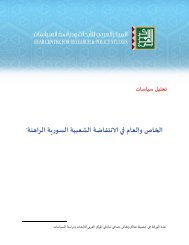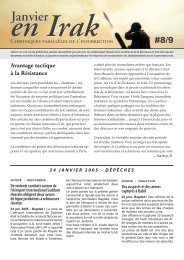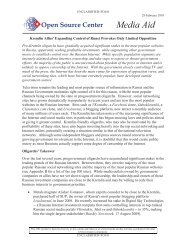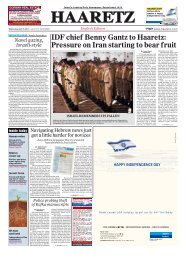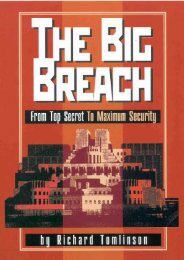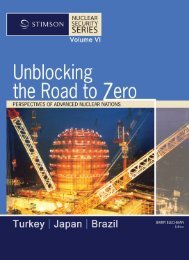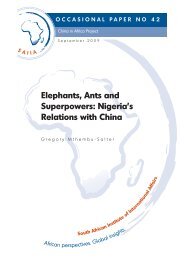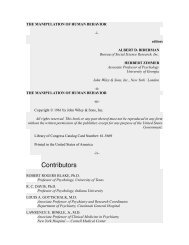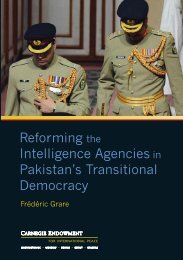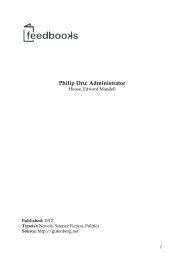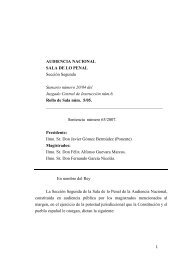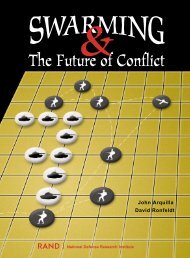Beyond START - Brookings Institution
Beyond START - Brookings Institution
Beyond START - Brookings Institution
You also want an ePaper? Increase the reach of your titles
YUMPU automatically turns print PDFs into web optimized ePapers that Google loves.
<strong>START</strong>. They might agree, for example, to a subceilingon ballistic missile warheads or a subceiling thatconstrained the percentage of total warheads on anyone element of the triad. The negotiators will haveto consider the advantages of subceilings as opposedto the simplicity of a single overall limit that allowseach side complete freedom to mix, that is, to choosehow it distributes its allowed warheads on its ICBMs,SLBMs, and heavy bombers.TimeU.S. and Russian negotiators have limited time. UnlessWashington and Moscow agree to extend <strong>START</strong>for an additional five years—something the Russianshave said they are not prepared to do—the treatywill expire on December 5. Given the need to havea follow-on agreement ratified by both the Senateand Russian Duma, a follow-on treaty probably willhave to be completed and signed by September. Indeed,Senator Richard Lugar, the ranking Republicanon the Senate Foreign Relations Committee, issueda statement on April 1 saying that any new treatywould have to be signed in early August in order toallow time for ratification. 15The timeline is daunting given how long it has taken tocomplete previous strategic agreements. Early <strong>START</strong>negotiations were suspended in 1983 when the Sovietswalked out in protest against the deployment ofU.S. intermediate-range nuclear missiles in Europe.<strong>START</strong> negotiations resumed in earnest in spring1985, but the treaty was only completed and signed inJuly 1991. Negotiating SORT took a relatively shortamount of time, spread over six months. It is, however,a far less meaningful and substantial agreement.Fortunately, much of the <strong>START</strong> experience, particularlywith monitoring and verification rules, canbe carried over into a new agreement with minimaladjustment. However, it may still be difficult to concludean agreement reducing each side to 1500 warheadsin time to have it ratified by December 5. If thisbecomes apparent and it looks like three-six months’more time might be needed, Washington and Moscowwill need to consider a bridging arrangement.(The Russians likely would not agree to an overlylong period, and it would be useful to maintain timepressure to complete the negotiations.)One example of a bridging arrangement would befor each side to announce that it would continue toobserve <strong>START</strong>’s provisions as a matter of nationalpolicy for three-six months. There is precedent forthis: the Reagan administration observed the termsof the signed but unratified Strategic Arms LimitationTreaty II (SALT II) until 1986 as a matter ofunilateral national policy. The Soviet Union had asimilar policy. (One issue for the Russian side wouldbe whether the military would require a legal basis inthe absence of <strong>START</strong> for continuing data exchangesand inspections. This involves release of informationthat the Russian government considers classified.)Counting RulesOne of the principal tasks for the negotiation willbe to determine the counting rule regime for the<strong>START</strong> follow-on treaty. While U.S. strategic forcesmay be at or nearing the SORT limit of 2200 warheads,applying the <strong>START</strong> counting rules to thenumbers of heavy bombers and strategic missiles inthe U.S. strategic arsenal yields a warhead count ofmore than 5500.<strong>START</strong>’s counting rules attribute a specific numberof warheads to each type of SNDV. For ICBMs andSLBMs, the counting rule was originally based onthe maximum number of warheads for which a missileof a particular type had been flight-tested. Forexample, under <strong>START</strong>, each Trident II missile wascounted as carrying eight warheads. A Trident submarine,with 24 SLBM tubes with Trident II SLBMsattributed with eight warheads each, thus counts ascarrying 192 warheads against the overall <strong>START</strong>warhead limit of 6000. On the Russian side, eachSS-18 ICBM counts as carrying ten warheads. The75 deployed SS-18 ICBMs therefore were attributedwith 750 warheads against Russia’s <strong>START</strong> aggregatelimit of 6000 warheads.SORT has no counting rules. It implies an actualloading count rather than the maximum attributednumber, but only the United States knows exactly10 B e y o n d <strong>START</strong>: Negotiating the Nex t Step in U.S. and Russian Strategic Nuclear Arms Reduc t i o n s



